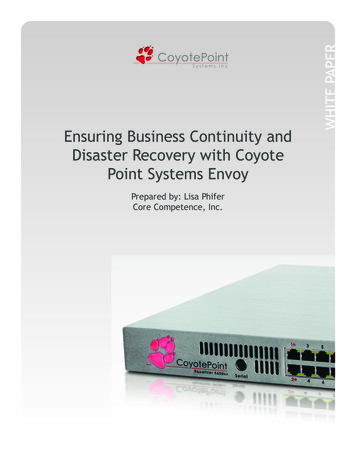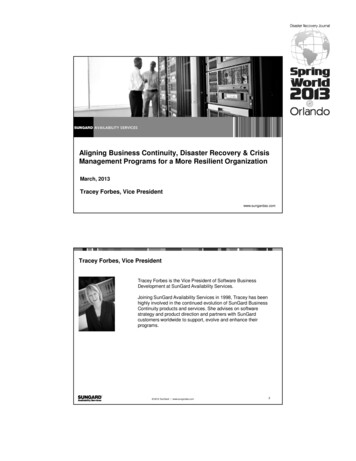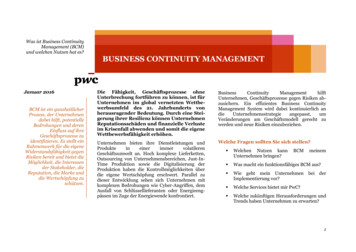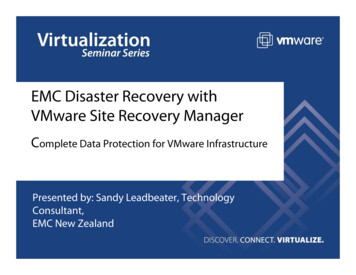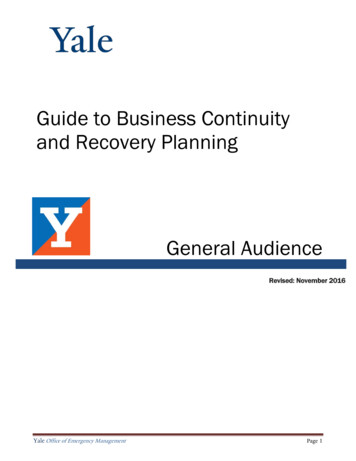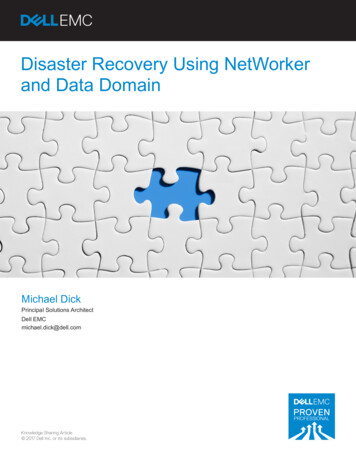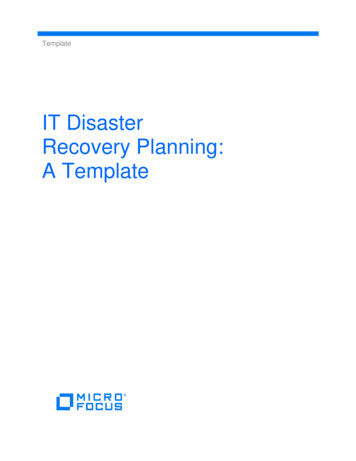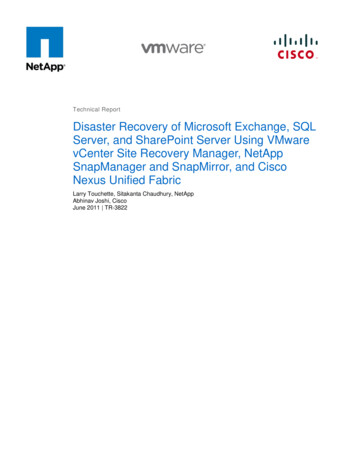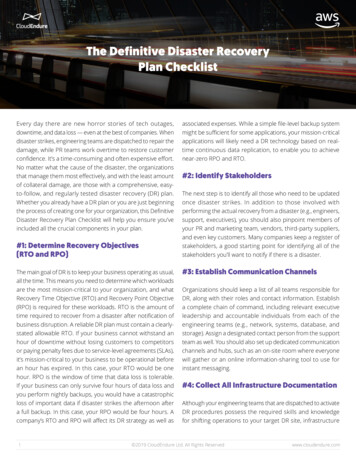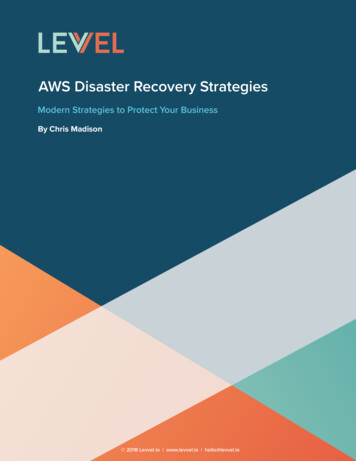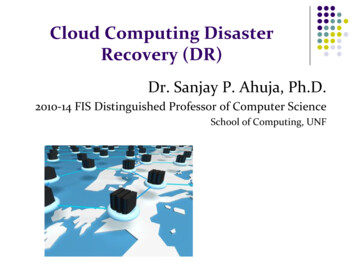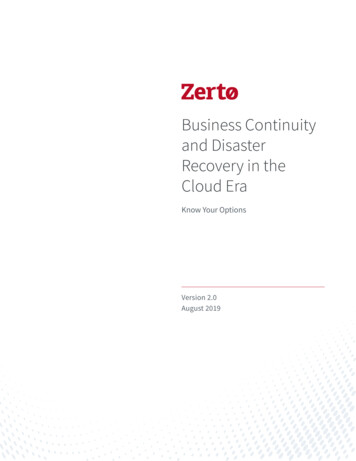
Transcription
Business Continuityand DisasterRecovery in theCloud EraKnow Your OptionsVersion 2.0August 2019
Business Continuity and Disaster Recovery (BC/DR) in the Cloud EraThe benefits of leveraging the cloud and virtualized environments are many, including greater flexibility and scalewithout incremental hardware costs coupled with agility to increase availability, business continuity and disasterrecovery to protect an “always on” customer experience for digital business. Today, enterprises of all sizes havevirtualized their mission-critical applications, either within their own datacenters, or with an external cloud provider.With cloud popularity ever increasing, companies of all sizes are looking for the cloud, be it public, hybrid orprivate, to become part of their BC/DR solution. However, depending on the tool, these options do not always exist.Virtualization creates the opportunity, but depending on the solution, there can still be a significant technology gap.Mission-critical applications can be effectively virtualized and managed, but if you use the wrong solution for BC/DR,they cannot be effectively protected in a cloud environment.Zerto is the industry’s first IT Resilience PlatformTM that is multi-hypervisor and public cloud capable, protectingapplications within the cloud and moving to the cloud, and has become the standard that all others are measured against.OverviewIn this paper, we’ll outline the different types of Cloud BC/DR solutions along with their pros and cons. Then, we’lldiscuss how Zerto addresses these challenges and improves upon many of the traditional solutions that leave gaps incloud-based BC/DR.Different Forms of Cloud BC/DRBefore we discuss the pros and cons, let’s briefly define the different forms cloud BC/DR can take:CloudDescriptionPrivate Cloud BC/DRBusiness continuity and disaster recovery between two or more geographically separatesites, with underlying hardware dedicated to the organization and often all under thecontrol of their own IT team.Public Cloud BC/DRBusiness continuity and disaster recovery between one or more sites under the control ofthe organization’s IT team and one or more public cloud platforms utilized as the recoverysite. In this deployment the BC/DR implementation is also managed by the organization’s ITteam internally.BC/DR in the Cloud EraWHITE PAPER
CloudDescriptionDisaster Recovery-as-a-Service(DRaaS)The production environment is within the enterprise’s datacenter; however, a cloud serviceprovider is used as the recovery site and replication target.In-Cloud BC/DRProduction applications have been moved to a public cloud and are protected by the cloudprovider with full disaster recovery to another geographical site.Multi-Cloud BC/DRProduction applications have been moved to a public cloud and are protected with fulldisaster recovery to another public cloud platform in another geographical region.Private Cloud BC/DRPrivate cloud BC/DR is very much the traditional approach from the early days of virtualization, mainly because theoriginal approach to BC/DR here relied upon storage level replication. This typically required identical hardware onboth sides. Because all hardware is dedicated to the organization and often managed by it too, capital expenditureis high and speed to scale is slow, with downsizing environments resulting in the writing off of hardware. Often arecovery site will exist with the sole purpose of being utilized in a disaster scenario only, creating inefficient spending.With this type of environment, IT teams are geared towards keeping the lights on, through management of thedatacenters, hardware and networks. This being said, there are some key reasons why private cloud BC/DR still exists.At the top of this list is control. With all hardware dedicated to the organization, absolute control is guaranteed andcan be beneficial in scenarios where compliance and regulation are tightly managed. Another important factor toconsider is performance. Some applications need huge amounts of resources and being able to align these to specifichardware can help provide the performance guarantees these applications require.Public Cloud BC/DRPublic cloud BC/DR is something that has seen significant uptake as the popularity of public cloud has grown overthe past few years. While in this scenario production remains under the control of the organization, often on-premisesand with the same caveats around scale and cost as mentioned previously, it provides some significant advantagestoo. With deployment in the public cloud, the cost of the recovery site can be drastically reduced, with a dedicatedenvironment no longer required and running for the purposes of recovery in the event of any potential disaster.Instead the benefits of public cloud can be utilized to provide a much more efficient cost for the recovery site. Forexample, with Zerto only storage is utilized on the target site until a recovery is required, removing the day to day costof compute. One of the main reasons this solution has seen so much growth is because it has delivered enterpriseclass BC/DR to smaller organizations who previously couldn’t justify the cost of a dedicated second site. There are,however, other considerations to this model. Control is lost as the underlying platform is managed by the cloudprovider meaning outages here are out of your hands, albeit this can be a positive attribute depending on your pointof view. Public cloud platforms are also multi-tenanted, so “noisy neighbors” do have the potential to impact theplatform. All in all, this is often a very effective first step to cloud adoption for many organizations.Disaster Recovery-as-a-ServiceDisaster Recovery-as-a-Service (DRaaS) allows organizations to host and manage their production environmentwithin their own datacenter but use a cloud service provider (CSP) to deliver BC/DR as a service to a cloud site. Thishas a lot of the same benefits as the previous model, with pay as you go compute pricing that eliminates the need forcapital expenditure and a managed platform, however it also takes it a step further. With DRaaS, CSPs will providemanagement of the BC/DR solution providing organizations with SLAs around Recovery Point Objectives (RPOs) andBC/DR in the Cloud EraWHITE PAPER
Recovery Time Objectives (RTOs), providing contracted guarantees and removing the overhead of managing thisthemselves. Because of this there is often a strong working relationship between the CSP and organization, not tomention the fact that most organizations will choose a local CSP in country.“We offer many DRaaS solutions but were looking for something that protected data at the VM-level and also offered very aggressiveservice levels. Zerto delivers RPOs of seconds and RTOs of minutes and with continuous data protection built in, our DR solution with Zertoalong with our internal team of experts gives us a clear competitive advantage.”— Dante Orsini, SVP Business Development, ilandIn-Cloud BC/DRIn-Cloud BC/DR is again an additional step forward from DRaaS. Instead of the organization running and managingtheir production environment on dedicated hardware in their own datacenter, this too is moved to the cloudproviders platform. BC/DR is then provided by protecting production from one of the CSPs datacenters to anothergeographically distant datacenter. BC/DR is then often fully managed by the CSP, as well as potentially providingmanagement where needed for the organization’s production environment. This then replicates all of the benefits ofmoving a recovery site to the cloud but applies also for the production site as well. Pay as you go pricing delivers costefficiencies for production, while the organization’s IT teams can focus more on business innovations rather than theday to day running of a datacenter. In addition, CSPs will be delivering SLAs for the production environment as well asBC/DR, with a close, often personal working relationship.“One of our core philosophies is that we do not want to pigeonhole customers into a solution. We work with them to understand theirbusiness needs fully and then customize an offering for them. Zerto is flexible and agile and can be integrated into any environmentwithout making any significant changes, supporting our ability to deliver an aligned infrastructure for each of our clients.”— Natalie Stewart, Product Manager, Node4Multi-Cloud BC/DRMulti-Cloud BC/DR is a model that has grown in popularity recently for a couple of reasons. First, the key driver hasbeen cloud adoption globally, with more and more organizations taking to the cloud. However, it is not unheard of foran organization to maintain a vendor agnostic approach for resilience reasons when looking at their BC/DR strategy.Essentially rather than taking the in-cloud BC/DR approach, the multi-cloud BC/DR model allows organizations toplace their production and recovery site on different cloud platforms. Should an issue ever take one cloud platformprovider offline, this solution would still provide the organization the ability to keep on doing business. The otherfactor driving this approach is the realization that not all cloud platforms suit all applications, some may need greaterregulation than others, which not all cloud platforms can meet for example, and so protecting these to different cloudplatforms can ensure maximum efficiency.Zerto OverviewZerto first introduced hypervisor-based replication in 2011 and revolutionized disaster recovery for VMWare andMicrosoft Hyper-V environments. Taking it into the Cloud, Zerto added support for Microsoft Azure, IBM Cloud andAmazon Web Services (AWS). Expanding its vision, Zerto now converges disaster recovery, backup and cloud mobilityinto a single IT Resilience Platform . This allows you to replace multiple legacy solutions with a single, simple andscalable platform that delivers a continuous, “always on” customer experience. Simplified workload mobility protects,recovers and moves applications freely across hybrid and multi-cloud environments with over 7,000 customersglobally now relying on Zerto’s platform.BC/DR in the Cloud EraWHITE PAPER
Zerto IT Resilience Platform Zerto’s IT Resilience Platform converges disaster recovery, backup, and workload mobility whether on-premises orto, from and between hybrid and multi-cloud environments. With support for VMware vSphere, Microsoft Hyper-V,Microsoft Azure, AWS, IBM Cloud and over 400 other Cloud Service Providers globally, Zerto’s agnostic approachcan deliver on any of the above models. Built on a foundation of continuous data protection (CDP) with built-inorchestration and automation capabilities, the platform provides you with simplicity, enterprise scale, and agiledata protection to save time, resources and costs. Analytics, with intelligent dashboards and live reports, gives youcomplete visibility across multi-site and multi-cloud environments and instills confidence that business service levelsand compliance requirements are met.Continuous Data Protection (CDP) Continuous Data Replication – Zerto delivers recovery point objectives (RPOs) of seconds by replicating everychange that is generated in near real-time. Performed at the platform level, this enables continuous capability byremoving any production impact, as well as providing a hardware and vendor agnostic approach. Journal-Based Recovery – All replicated changes are stored in a journal for up to 30 days providing incrediblerecovery granularity through checkpoints inserted every few seconds. This reduces data loss to just seconds byenabling recovery of files, VMs, applications or entire sites, either to the latest point-in-time or, for example, whenthe virtual machine (VM) is attacked by a virus or ransomware, to a point-in-time before the attack. Application Consistency – Today’s applications are rarely run on a single VM, but instead most applications havemultiple VM dependencies. Traditional methods of protecting VMs individually result in significant challengesto recovering complete applications quickly. Zerto resolves this by using our Virtual Protection Group (VPG)capability. VPGs allow you to protect multiple VMs together in a consistent fashion, ensuring every point in timethat is inserted into the Zerto Journal is from the same point in time for all VMs within the VPG. This allowsconsistent recovery of an entire application, and all its VM dependencies, to a consistent point in time. Long-Term Retention – Compliance standards often require you to keep, and ultimately recover data, for longerthan 30-days. Long-term retention utilizes your existing journal to store data from any point in time for days,weeks, months or even years with no production impact. Scalability – Zerto simplifies scaling the infrastructure to support disaster recovery. As a new virtual host is added,simply install a new virtual appliance. Although Zerto scales to support very large environments, it provides thesame granularity for environments of all sizes, with the same capabilities and no production impact.BC/DR in the Cloud EraWHITE PAPER
Orchestration & AutomationBuilt in orchestration and automation enables faster management of workloads at scale with minimal touch, allowingIT resources to shift their focus toward innovation and services that help your business run more efficiently. Zerto’s platform supports your multi-cloud and hybrid cloud strategy, including VMware, Hyper-V, Azure, IBMCloud, AWS and hundreds of Cloud Service Providers (CSPs). All recovery settings are configured up-front, such as boot order and re-IP failover, well before any disaster orother event occurs, thus greatly simplifying the recovery process. In fact, it’s so simple, any member of your ITteam could perform it in just 3 clicks. You can configure different settings for test failovers, ensuring that test failovers/moves can be run at any timewith zero impact on production or protection.Analytics & ControlZerto Analytics, included in the IT Resilience Platform, provides one single, comprehensive view of your entiremulti-site, multi-cloud environment. Built-in intelligent dashboards provide real-time and historical analysis of thehealth and protection status of your applications and data. Metrics such as average RPO, network performance, andstorage consumption, help you spot trends, identify anomalies, and troubleshoot issues. The powerful resourceplanning capability continuously monitors and analyses compute, storage and network resources across on-premisesenvironments and public, private and hybrid clouds to give you confidence of your resource requirement needs.‘What-if’ scenario modelling delivers accurate planning of future storage, compute and network resources. ZertoAnalytics helps you make better informed decisions and plans, to achieve an efficient, IT resilient mode of operation.To learn more, visit the Zerto for Azure on demand lab or request a demo.Zerto helps customers accelerate IT transformation by eliminating the risk and complexity of modernization and cloudadoption. By replacing multiple legacy solutions with a single IT Resilience Platform, Zerto is changing the way disasterrecovery, data protection and cloud are managed. With enterprise scale, Zerto’s software platform delivers continuousavailability for an always-on customer experience while simplifying workload mobility to protect, recover and moveapplications freely across hybrid and multi-clouds. www.zerto.comCopyright 2019 Zerto. All information may be subject to change.IS-13153About Zerto
without incremental hardware costs coupled with agility to increase availability, business continuity and disaster recovery to protect an “always on” customer experience for digital business. Today, enterprises of
